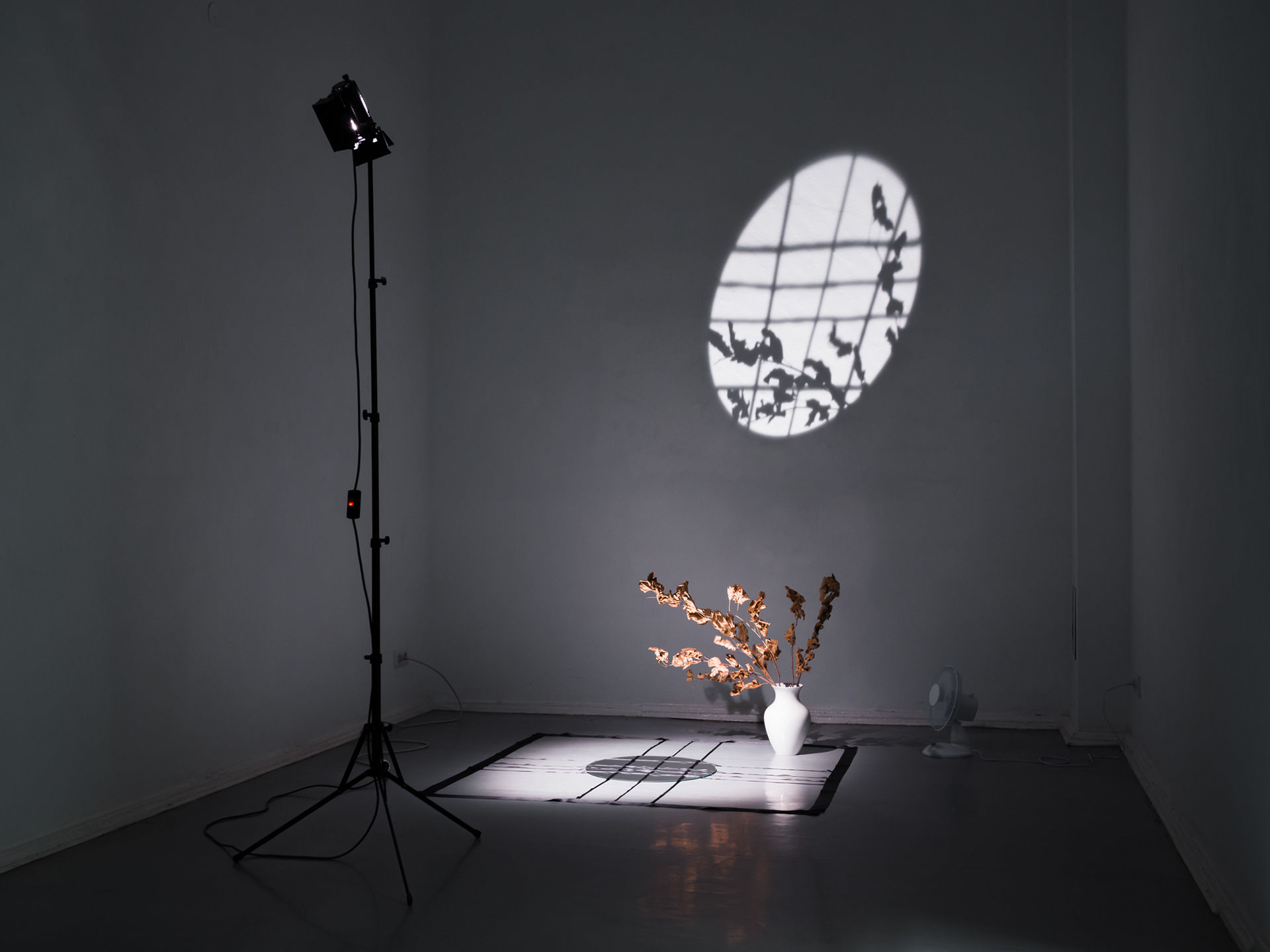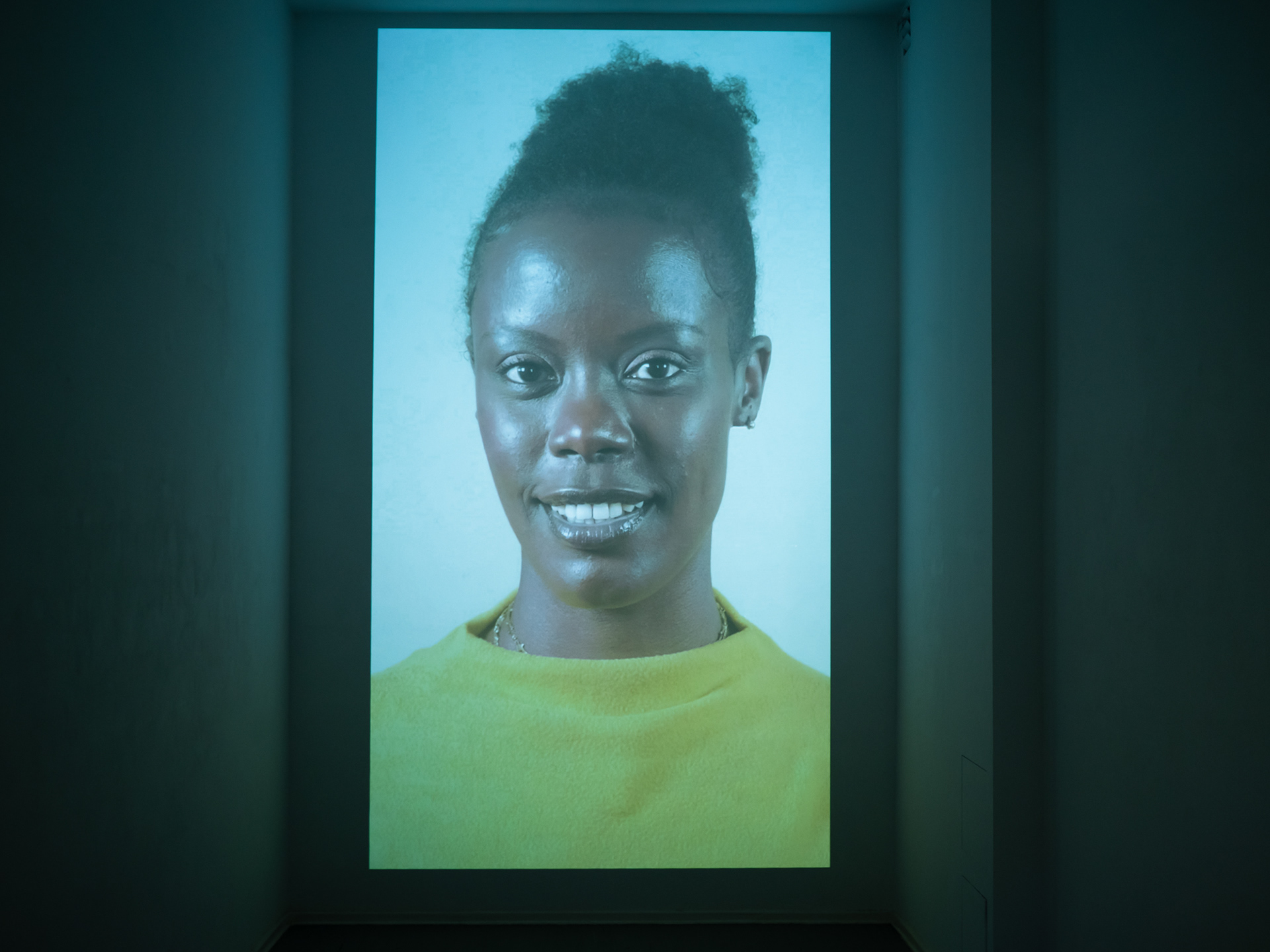Few topics have been such a strong source of artistic inspiration as the night. But what is it about the dark hours that has attracted artists for centuries and continues to do so? Shadow Came Before The Sun places the works of 13 Berlin-based artists at the centre of this discussion. The show’s ethos is best encapsulated in Vincent Van Gogh’s words: “I often think that the night is more alive and more richly coloured than the day."
Kristian Askelund, Mineral Rights 2 - North Sea Oil Drilling, 2021
In his light sculpture, Kristian Askelund welcomes us into the world of the luminous night. With its beaming orange light, a sense of urgency is created, bringing us to the biggest issue of our time: the overexploitation of natural resources and the looming menace of climate change as a consequence. While at first glance the inconspicuous outline of northern European countries catches the eye, holes within the paper demand attention, sparkling while letting the light through directly. Each hole represents an offshore oil drilling platform, symbolising the constant light pollution emanating from flares, burning off natural gas as a waste product. And from literal maps, to the maps of inner turmoil: Luca Cuozzo’s illustrations function as a torchlight to orient oneself through the deepest places within. His sculpture Those Radiant Moments Of Shine turns an unsettling quietness into a disfigured, almost mummified presence, elevating itself as a means of reaching out for a distorted reality. For the artist, this fragile creature symbolises an empowering portrait of the crave for clarity.

Luca Cuozzo, Those Radiant Moments Of Shine, 2021

Andrea Breinbauer, The Disenchanted's Drama, 2016
Ute Vauk-Ogawa, Prolonged State Of Stillness, 2021 (© VG Bild-Kunst, Bonn 2021)
In Andrea Breinbauer’s painted scenographies, the viewer can have a glimpse into a state of surrealness best described as dream logic: the information that the brain processes during our sleep, bringing a sense of chaos and illogical reality to the experience of sleeping. An ominous tranquility points to an intermediate state of unconsciousness and a playfulness that feels staged yet spontaneous. This foreboding calm is also present in Ute Vauk-Ogawa’s sculptural works Prolonged State of Stillness, which consists of dark humanoid figures suspended in wooden frames. The figures are infused with a sense of urge and movement, but seem to have frozen in time, even contained, as remarked by the strings that hold them. The fact that the frames are inscribed points to a readiness to be released. This longing for freedom is also a direct connection to the artist’s own ambivalent experience with the dark hours, towards which she felt deep respect during her childhood, and which turned into an endless source of inspiration in later years.
Kerstin Kary, The Pack / Blanc Feuillage, 2014
But human stillness during nighttime invites other creatures to roam free. With glowing eyes in the dark, almost as if reflecting the lights of a passing car or flashlight, Kerstin Kary offers in her paintings glimpses into the world of nocturnal animals, briefly illuminated for the human eye to witness. We are let into a universe that is almost alien to us humans, diurnal animals who need artificial light to find our way through the hours of the night. With this series of paintings, the artist intends to focus on what happens in the dark and in the absence of noise in the forest, where every small crack or shriek feels louder and heavier.

Ulrich Vogl, Window Pasolini, 2014

Sina Samavati, من نمیخوام شکنجه شم (I Don’t Want To Be Tortured), 2021
The night can also act as a place of refuge. Like in Ulrich Vogl’s intimate, contemplative installation, which is inspired by a specific period in the life of Pier Paolo Pasolini, during WWII, when he was concealed with his mother in a small chapel outside of San Vito, Northern Italy. Window Pasolini was created for an exhibition that took place in silk mill in that place. A dim lamp, reflected via a mirror, creates a scene reminiscent of a calm full moon night, with mulberry branches quietly rustling in a breeze. These branches were collected from a tree next to the chapel from which he was ultimately expelled, after his homosexuality was discovered. The high price of refuge is also made evident in Sina Samavati’s multi-layered video work, in which he explores insomnia through memories of teenage angst and complex. A tale of self-identity and the emotional implications of life in diaspora, the work also deals with notions of religion, class and exile, contextualised by the existential threat of having to return to a home that is no longer.
Samir Nahas, Essay_21, 2013
Clémentine Rettig, Flutter, 2021
Challenging the beliefs that there is only quiet in the night are the following three artists, by showing the unheard, the unseen or even the uncatchable of this time. In Samir Nahas’ video Essay_21, the main character tirelessly patrols the streets at night, trying to capture the moon while reflecting on the process that gives shape to the work. For the artist, capturing this celestial body is the result of an intense methodology of nightly habits, having taken three months of wandering the streets of a city at night, allowing himself to be swallowed by the atmosphere he encountered. Capturing the night is also present in Clémentine Rettig’s work Flutter, this time through a sound installation that invites its guests to be transported to the French Pyrenees, allowing the sounds of the night to reveal themselves and letting the different phases from dusk to night take centre stage. A series of sculptures completes the installation. Shaped as organic, physical echoes of nature, they examine the fragility and instantaneity of the natural environment. Kirsten Heuschen’s wall installation Multiply literally captures the light of the sun onto event posters she collected from the streets, via cyanotypes, and brings it to a nightscape context, highlighting the strong blueness and texture of dusk. Claiming that the night feels endless to her, she uses her work to transport the viewer into an immersive walk along dark alleys, where shadows take their place to be alive or lost loved ones reappear to accompany the journey.
Kirsten Heuschen, Multiply, 2019 (© VG Bild-Kunst, Bonn 2021)
Soji Shimizu, Untitled (Drive), 2019-2021
Soji Shimizu’s paintings take us on nightly car rides, aimlessly traversing the dark landscapes looking for something that he ultimately withholds from the viewer. In his paintings, he seeks to show that the night can emphasise the light instead of hiding colours. Rich, saturated blues show a scene in two snapshots, a momentary chance encounter between the driver of a car and a cat. Piercing glowing eyes appear in the beam of the headlights at the side of a road ahead, as well as in the rearview mirror. Fleeting experiences and sights leaving subconscious afterimages, just like in the third canvas, which shows a dark forest in calm tones of grey.

Riccardo Buck, Booklet Of Portraits: Working At Night Loading Trucks, 2019

Pako Quijada, Acta Nocturna, 2021
Some of the highest earning players in today’s capitalist system rely heavily on the efforts of night workers. Created during a period in which he was employed loading delivery trucks, Riccardo Buck’s intimate notebook of drawings of his colleagues was originally meant as a farewell gift for their team lead. Decontextualised, it could be read as a protest against the hard work carried out in the late hours to meet the high demands of a society that won’t reflect on their consumerist actions. Drawing during his work breaks, he puts faces to an often faceless labour and reclaims the right to be seen, even when being part of an apparatus that is often hidden from sight. But what would be of this highly perfected mechanism without the power of marketing? Pako Quijada’s film Acta Nocturna offers one of the few glimpses of humour in this exhibition, by thematising the absurdity of marketing, preying on the tiredness and desperation of the chronically sleep-deprived viewer. They use influences from a multitude of sources to portray how something as banal as sleeping is being marketed as an experience, with corporations presenting it as something in need of constant fine-tuning and optimisation . Just like Pavlov’s dogs, the viewer-turned-consumer is conditioned by the repetition of messages, being asked more and more by the service provider, to the point where they end up becoming the product.
The night ultimately uncovers itself as an often tumultuous yet sacred hiding place, not only for its subject matter, but also for the artists themselves.
About Othergrounds
Othergrounds is a Berlin based project by a collective of artists/curators with a strong focus on art that pursues political impact and engagement with the local community of artists. We also look for art that invites nature as a direct and important part of the creative process. We believe that art can be utilised as a powerful political tool and that artists can function as a seismograph to injustice and environmental causes of the time they live in. This project is intended to be fluid in its structure, with a group of core curatorial team members, but open to collaborations with other artists and curators.
Shadow Came Before The Sun is our third exhibition, and is sponsored by Ecosia, the search engine that plants trees with their profits. For more information, visit our othergrounds.org or follow us on Instagram (@othergrounds).
